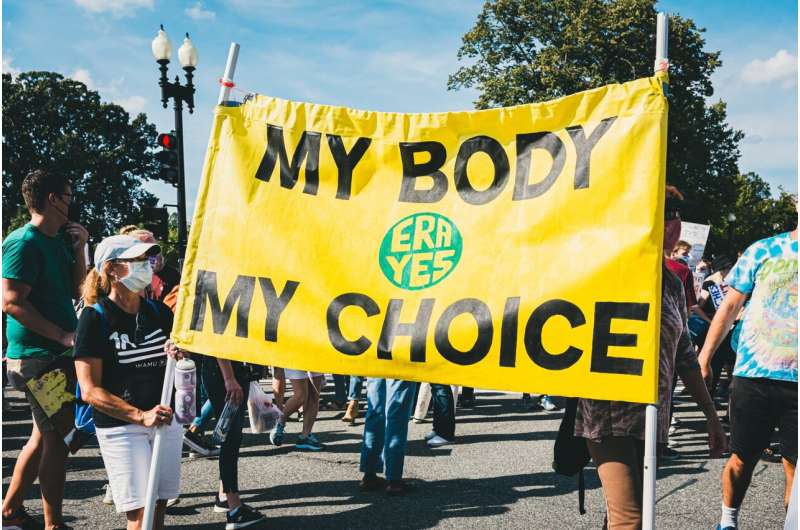This article has been reviewed according to Science X's editorial process and policies. Editors have highlighted the following attributes while ensuring the content's credibility:
fact-checked
trusted source
proofread
Experts examine the abortion rights landscape a year after the US Supreme Court overturned Roe v. Wade

It's been almost a year since the U.S. Supreme Court overturned Roe v. Wade, dismantling the constitutional right to abortion more than 50 years after the case was decided.
Now, the legal battleground of reproductive rights has grown even more tense. At least a dozen states have banned abortion entirely, and more states are seeking to further restrict access to abortion—making the U.S. an outlier on the global stage: Some 59% of the world's female population currently reside in a country where abortion is broadly allowed.
"And generally over the past several decades, there has been a trend toward increasing liberalization. So this is part of a very unique change in policy happening in the U.S.," Suzanne Bell, BSPH '18 (Ph.D.), said during a recent media briefing.
During the briefing, Bell, an assistant professor in Population, Family and Reproductive Health at the Bloomberg School, and Joanne Rosen, a senior lecturer in Health Policy and Management, discussed the state of abortion access in the U.S. and the impact on women's health—and on physicians—since Roe was overturned. They outlined how abortion restrictions worsen health disparities, how states have responded to Roe's dismantling, and the potential ramifications of litigation to restrict access to medication abortion for women across the country.
How states have responded
With federal protections for abortion overturned, states were empowered to regulate reproductive health without the constitutional constraints that had operated for the past 50 years. Rosen noted that some have passed legislation shoring up access to abortion.
Fifteen states where abortion remains legal have enacted various additional protections, such as permitting the use of state funds to cover abortion costs; allowing non-physician health professionals to perform abortions; protecting physicians from prosecution, extradition, or other legal action by states that have banned abortion; and prohibiting the disclosure of patients' medical records without patient permission.
Other states, however, have moved to further erode access, Rosen explained. Even before Dobbs was decided, abortion-hostile states enacted 108 abortion restrictions—in 2021 alone. This is the single highest number of abortion restrictions in any year since Roe was decided in 1973, according to the Guttmacher Institute. In the year since Dobbs was decided, abortion has been banned in 14 states.
Efforts to ban medication abortion nationwide
A Texas case seeking to revoke the FDA's approval of the safe and effective drug mifepristone—which was used in 53% of abortions in 2020—has "extraordinary" implications that go beyond the possibility of taking mifepristone off the shelves, said Rosen.
The litigation also sets a dangerous precedent for court interference in the FDA's scientific approval process. If the plaintiffs are successful, it "would be the first time a court has abrogated the FDA's approval of a drug over the objections of the FDA," Rosen explained. The consequences could be far-reaching, potentially affecting access to any number of drugs.
Other efforts to abolish abortion center on reviving the Comstock Act, an 1873 law banning, among other things, the mailing or transport of "[e]very article or thing designed, adapted, or intended for producing abortion." The Comstock Act is one of many "zombie laws"—meaning they've long been considered invalid but remain technically on the books—that could see a revival given the precedent set by overturning Roe and Planned Parenthood v. Casey, the 1992 decision that upheld the right to abortion.
Other laws with a similar potential for revival or reenactment following Dobbs concern bans on contraceptives, bans on consensual same-sex sexual activity, and bans on interracial marriage.
Concerns for physicians
The wave of abortion bans have broader implications for the health care workforce.
For one, physicians working in states that ban abortion must contend with "risk management committees" set up by hospitals to determine whether an abortion is warranted in an urgent health care situation where the life of a pregnant person is at risk. "In this context, physicians are finding it difficult to use best medical practices to protect their patients' well-being"—and they're concerned about the genuine risk of criminal prosecution, Rosen said.
In this environment, it's getting harder for hospitals in abortion-hostile states to attract and retain obstetricians and gynecologists, and raising questions about the future of training for these specialties in those states.
"Are the people who receive training in those states just not going to receive the appropriate training? I think we have yet to see what those full ramifications are," Bell said.
Deepening disparities
All of these challenges stand to exacerbate existing disparities in access to quality reproductive health care, Bell added.
"Before Dobbs, Black women were three times as likely, and Hispanic women twice as likely, to seek abortions than white women. And half of all women who received abortions were living below the poverty line—many of them in states that now limit or are seeking to limit abortions," explained Bell.
Being denied an abortion comes with substantial health risks—especially for vulnerable groups. The risk of maternal death is 15 times higher for carrying a pregnancy to term than it is for abortion, and pregnancy-related complications are 2 to more than 25 times higher for pregnancies ending in birth compared to abortion, Bell explained.
"These restrictions may be exacerbating existing maternal health disparities within the U.S.," Bell said, adding that those restrictions undermine the delivery of basic services. "We have maternal mortality rates that are in some cases twice as high in restrictive states as they are in supportive abortion states."
"I want to emphasize that abortion is health care," Bell said. "Recent state restrictions, coupled with ongoing efforts to curtail access to medication abortion pills nationwide, are an attempt to interfere with the delivery of evidence-based health care and control pregnant people's bodies, with harmful consequences for individuals and population health."



















